Abstract
The effects of DDD (fully automatic) and VVI (ventricular demand) pacing modes on exercise tolerance, symptom diary cards, and Holter monitoring were investigated in a randomised double blind crossover study of 16 patients who had had DDD pacemakers implanted because of frequent syncope. Eight patients presented with sick sinus syndrome and, with one exception, retrograde atrioventricular conduction and eight age and sex matched patients presented with 2:1 or complete atrioventricular block. Maximal symptom limited exercise in those with atrioventricular block was significantly higher after one month of DDD pacing than after VVI pacing. In those with sick sinus syndrome, however, maximal effort tolerance was not significantly different for the two pacing modes. In all but one patient with sick sinus syndrome sinus rhythm developed during exercise in VVI pacing. For both VVI and DDD modes maximal atrial rates were significantly lower in those with sick sinus syndrome. Palpitation and general wellbeing were significantly improved during DDD pacing in the eight patients with sick sinus syndrome. Shortness of breath was improved by DDD pacing in the eight patients with atrioventricular block but not in those with sick sinus syndrome. Holter monitoring showed that sick sinus syndrome patients remained in paced rhythm, either DDD or VVI, for most of the 24 hour period. DDD pacing was better than VVI pacing in sick sinus syndrome with retrograde atrioventricular conduction. Despite their ability to show sinus rhythm and inhibit their pacemakers on exercise patients with sick sinus syndrome are just as likely to have symptomatic benefit from DDD pacing as patients with atrioventricular block.
Full text
PDF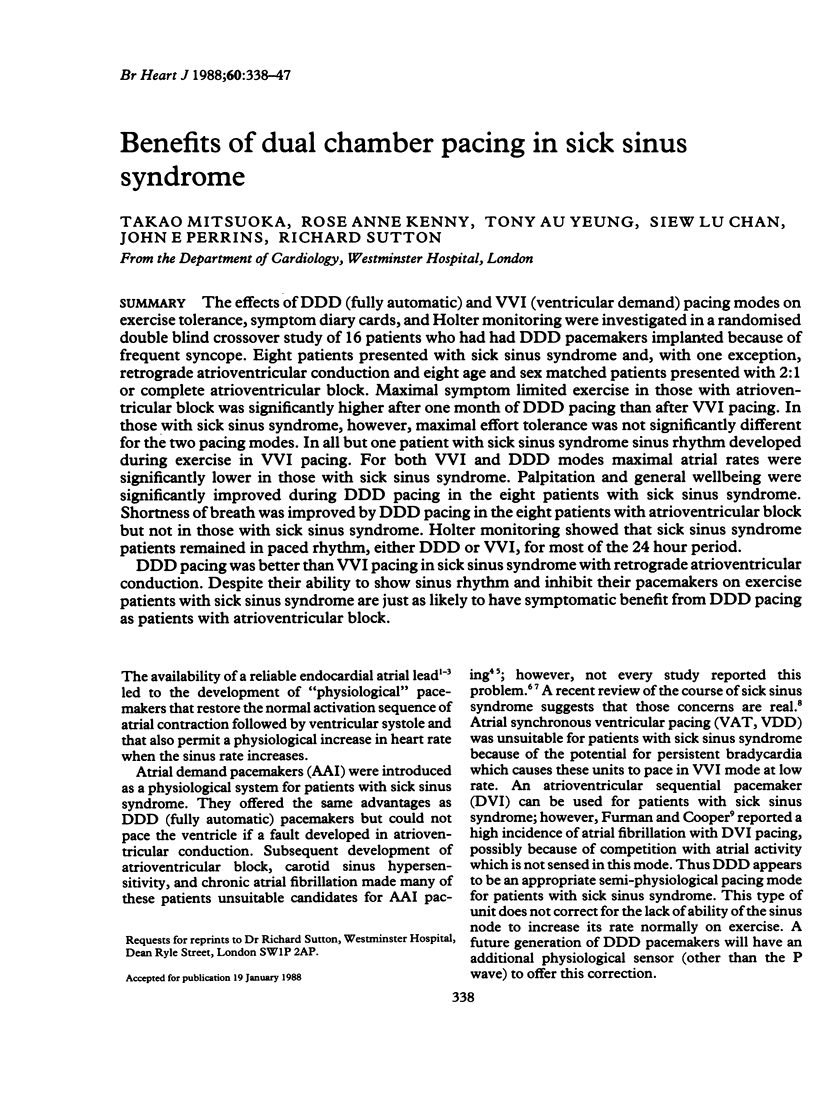
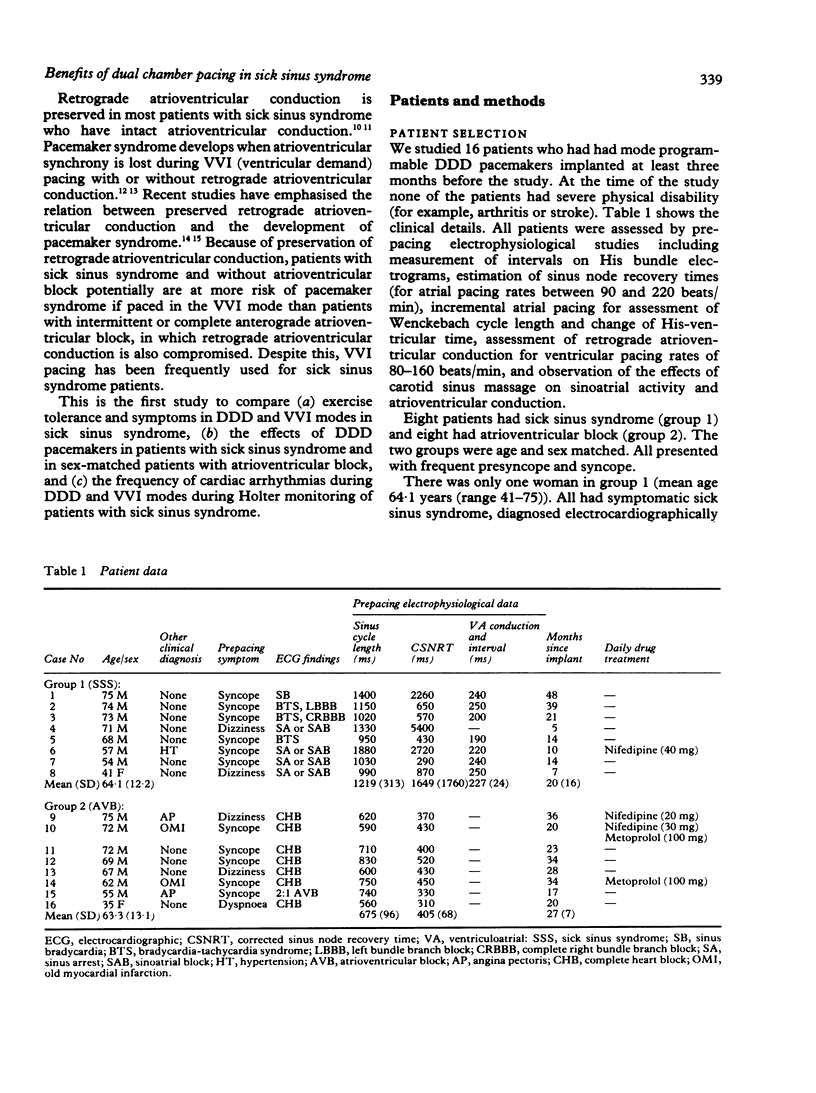
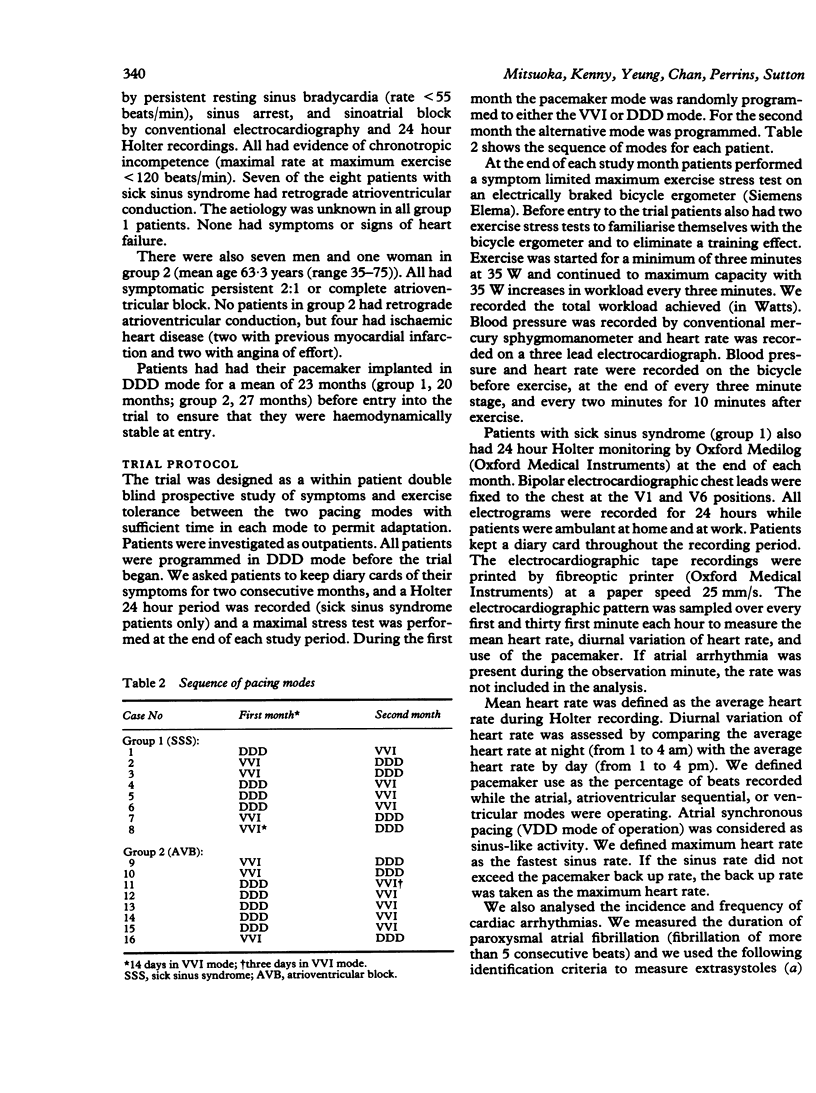
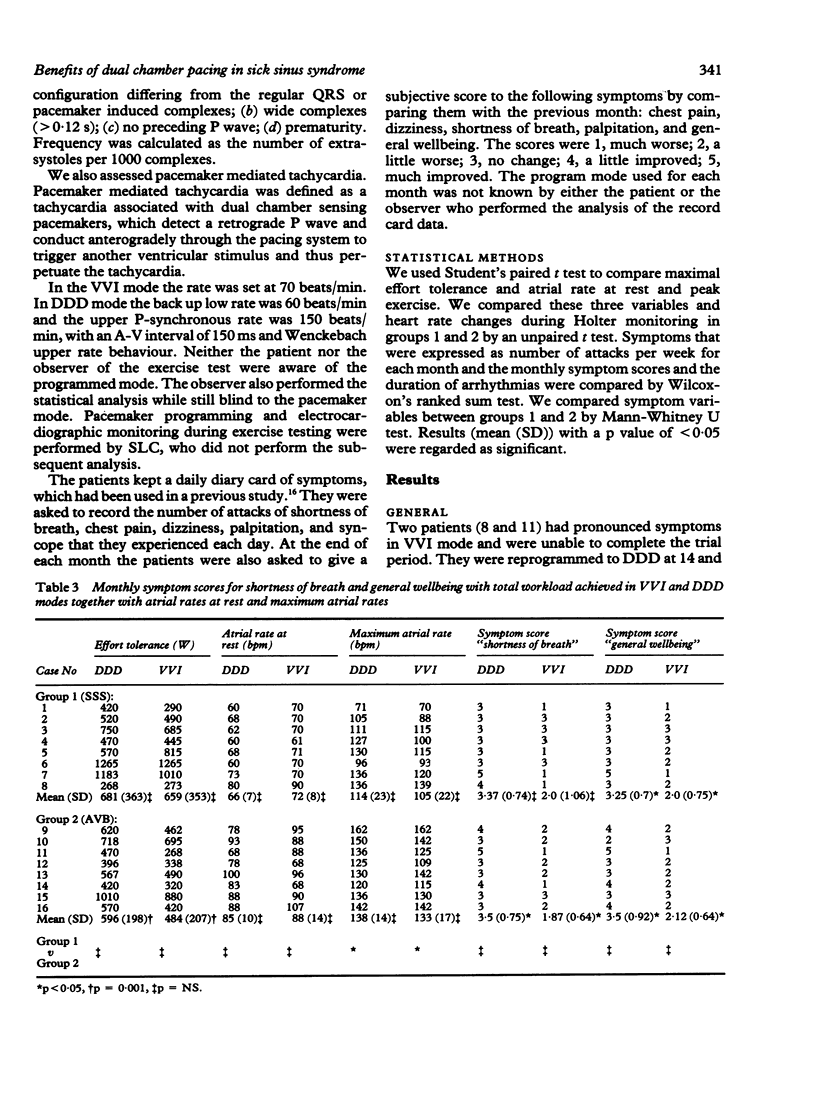

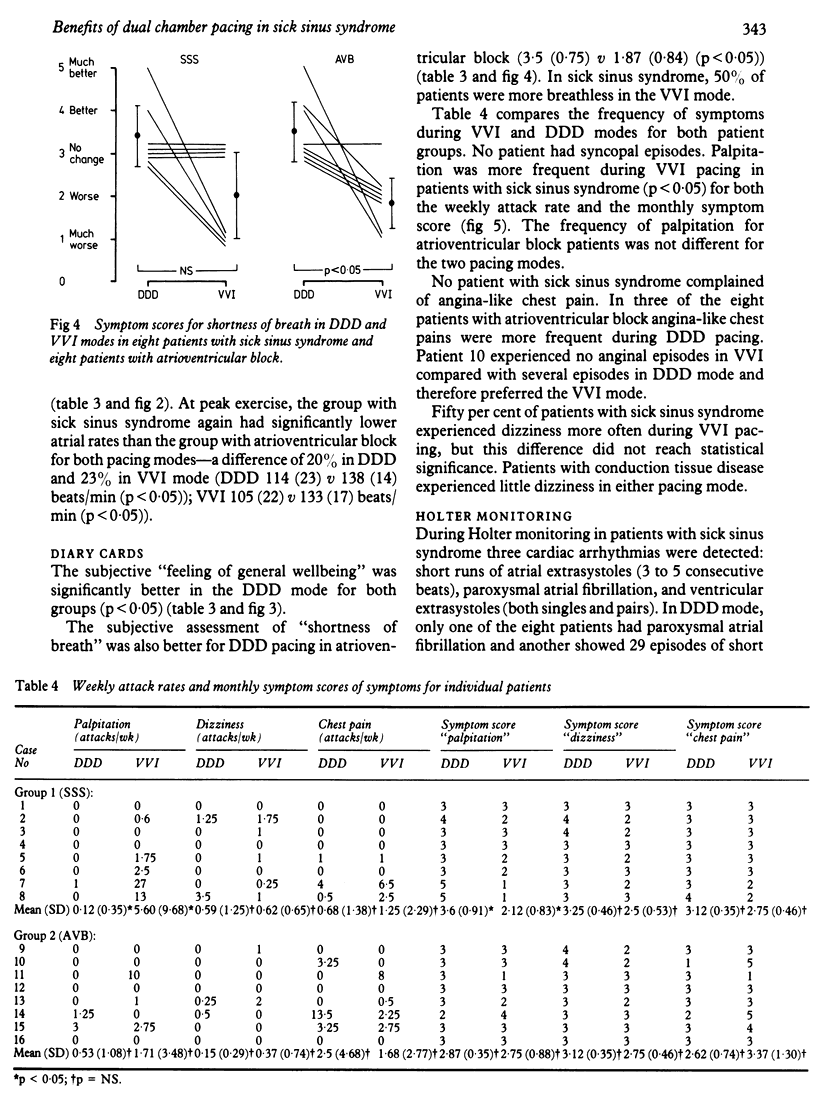

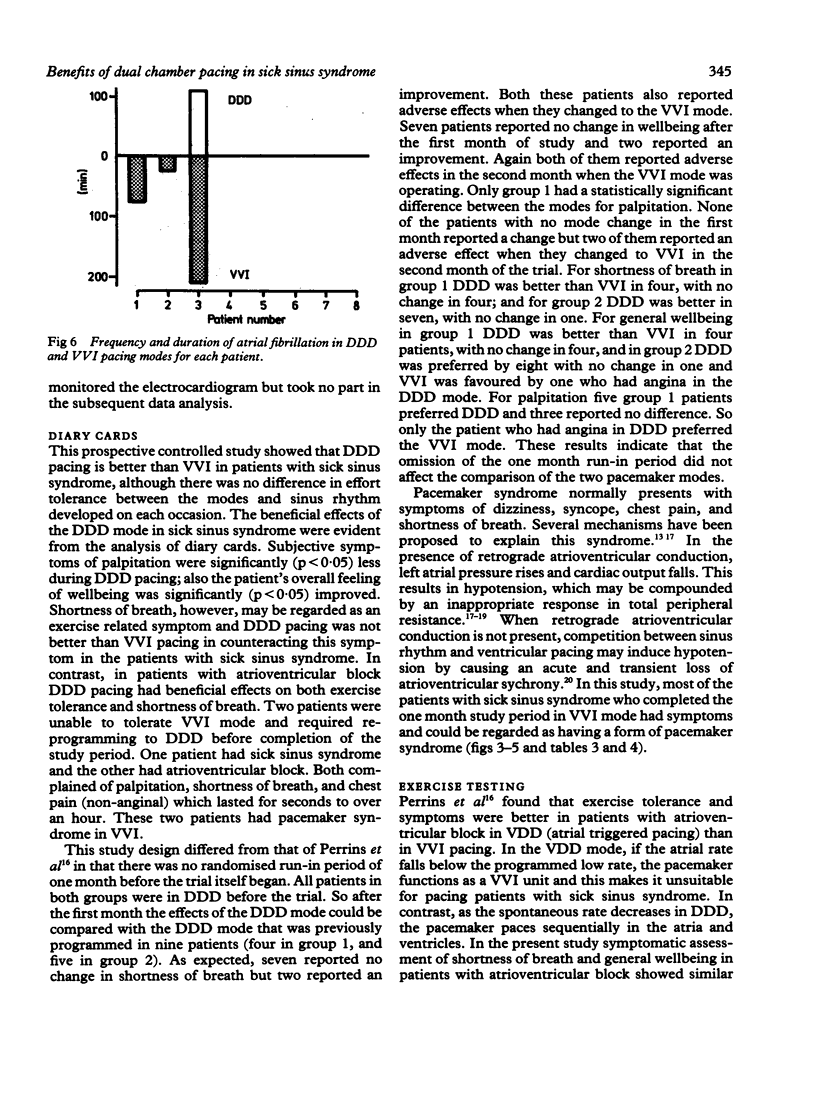

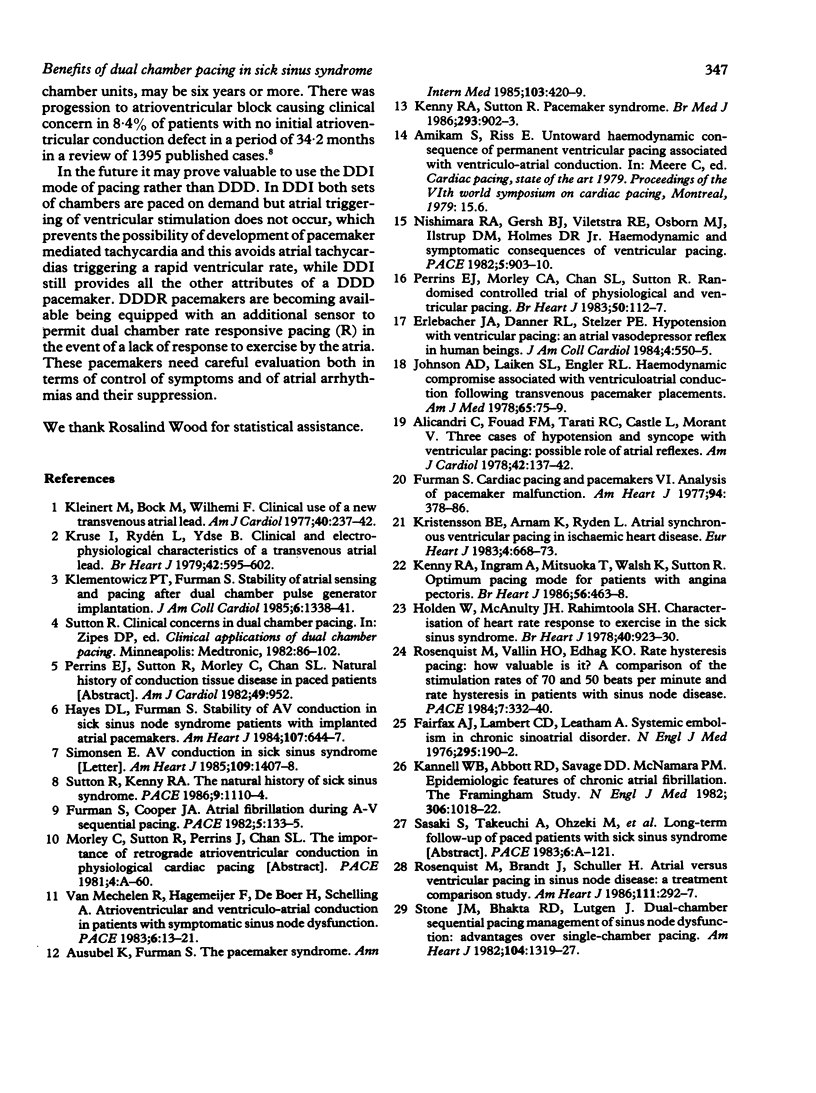
Selected References
These references are in PubMed. This may not be the complete list of references from this article.
- Alicandri C., Fouad F. M., Tarazi R. C., Castle L., Morant V. Three cases of hypotension and syncope with ventricular pacing: possible role of atrial reflexes. Am J Cardiol. 1978 Jul;42(1):137–142. doi: 10.1016/0002-9149(78)90998-0. [DOI] [PubMed] [Google Scholar]
- Ausubel K., Furman S. The pacemaker syndrome. Ann Intern Med. 1985 Sep;103(3):420–429. doi: 10.7326/0003-4819-103-3-420. [DOI] [PubMed] [Google Scholar]
- Erlebacher J. A., Danner R. L., Stelzer P. E. Hypotension with ventricular pacing: an atria vasodepressor reflex in human beings. J Am Coll Cardiol. 1984 Sep;4(3):550–555. doi: 10.1016/s0735-1097(84)80100-x. [DOI] [PubMed] [Google Scholar]
- Fairfax A. J., Lambert C. D., Leatham A. Systemic embolism in chronic sinoatrial disorder. N Engl J Med. 1976 Jul 22;295(4):190–192. doi: 10.1056/NEJM197607222950403. [DOI] [PubMed] [Google Scholar]
- Furman S. Cardiac pacing and pacemakers VI. Analysis of pacemaker malfunction. Am Heart J. 1977 Sep;94(3):378–386. doi: 10.1016/s0002-8703(77)80483-3. [DOI] [PubMed] [Google Scholar]
- Furman S., Cooper J. A. Atrial fibrillation during A-V sequential pacing. Pacing Clin Electrophysiol. 1982 Jan;5(1):133–135. doi: 10.1111/j.1540-8159.1982.tb02201.x. [DOI] [PubMed] [Google Scholar]
- Hayes D. L., Furman S. Stability of AV conduction in sick sinus node syndrome patients with implanted atrial pacemakers. Am Heart J. 1984 Apr;107(4):644–647. doi: 10.1016/0002-8703(84)90309-0. [DOI] [PubMed] [Google Scholar]
- Holden W., McAnulty J. H., Rahimtoola S. H. Characterisation of heart rate response to exercise in the sick sinus syndrome. Br Heart J. 1978 Aug;40(8):923–930. doi: 10.1136/hrt.40.8.923. [DOI] [PMC free article] [PubMed] [Google Scholar]
- Johnson A. D., Laiken S. L., Engler R. L. Hemodynamic compromise associated with ventriculoatrial conduction following transvenous pacemaker placement. Am J Med. 1978 Jul;65(1):75–79. doi: 10.1016/0002-9343(78)90695-2. [DOI] [PubMed] [Google Scholar]
- Kannel W. B., Abbott R. D., Savage D. D., McNamara P. M. Epidemiologic features of chronic atrial fibrillation: the Framingham study. N Engl J Med. 1982 Apr 29;306(17):1018–1022. doi: 10.1056/NEJM198204293061703. [DOI] [PubMed] [Google Scholar]
- Kenny R. A., Ingram A., Mitsuoka T., Walsh K., Sutton R. Optimum pacing mode for patients with angina pectoris. Br Heart J. 1986 Nov;56(5):463–468. doi: 10.1136/hrt.56.5.463. [DOI] [PMC free article] [PubMed] [Google Scholar]
- Kenny R. A., Sutton R. Pacemaker syndrome. Br Med J (Clin Res Ed) 1986 Oct 11;293(6552):902–903. doi: 10.1136/bmj.293.6552.902. [DOI] [PMC free article] [PubMed] [Google Scholar]
- Kleinert M., Bock M., Wilhemi F. Clinical use of a new transvenous atrial lead. Am J Cardiol. 1977 Aug;40(2):237–242. doi: 10.1016/0002-9149(77)90014-5. [DOI] [PubMed] [Google Scholar]
- Klementowicz P. T., Furman S. Stability of atrial sensing and pacing after dual chamber pulse generator implantation. J Am Coll Cardiol. 1985 Dec;6(6):1338–1341. doi: 10.1016/s0735-1097(85)80222-9. [DOI] [PubMed] [Google Scholar]
- Kristensson B. E., Arnman K., Rydén L. Atrial synchronous ventricular pacing in ischaemic heart disease. Eur Heart J. 1983 Sep;4(9):668–673. doi: 10.1093/oxfordjournals.eurheartj.a061540. [DOI] [PubMed] [Google Scholar]
- Kruse I., Rydén L., Ydse B. Clinical and electrophysiological characteristics of a transvenous atrial lead. Br Heart J. 1979 Nov;42(5):595–602. doi: 10.1136/hrt.42.5.595. [DOI] [PMC free article] [PubMed] [Google Scholar]
- Nishimura R. A., Gersh B. J., Vlietstra R. E., Osborn M. J., Ilstrup D. M., Holmes D. R., Jr Hemodynamic and symptomatic consequences of ventricular pacing. Pacing Clin Electrophysiol. 1982 Nov;5(6):903–910. doi: 10.1111/j.1540-8159.1982.tb00029.x. [DOI] [PubMed] [Google Scholar]
- Perrins E. J., Morley C. A., Chan S. L., Sutton R. Randomised controlled trial of physiological and ventricular pacing. Br Heart J. 1983 Aug;50(2):112–117. doi: 10.1136/hrt.50.2.112. [DOI] [PMC free article] [PubMed] [Google Scholar]
- Rosenqvist M., Brandt J., Schüller H. Atrial versus ventricular pacing in sinus node disease: a treatment comparison study. Am Heart J. 1986 Feb;111(2):292–297. doi: 10.1016/0002-8703(86)90142-0. [DOI] [PubMed] [Google Scholar]
- Rosenqvist M., Vallin H. O., Edhag K. O. Rate hysteresis pacing: how valuable is it? A comparison of the stimulation rates of 70 and 50 beats per minute and rate hysteresis in patients with sinus node disease. Pacing Clin Electrophysiol. 1984 May;7(3 Pt 1):332–340. doi: 10.1111/j.1540-8159.1984.tb04914.x. [DOI] [PubMed] [Google Scholar]
- Simonsen E. AV conduction in sick sinus syndrome. Am Heart J. 1985 Jun;109(6):1407–1408. doi: 10.1016/0002-8703(85)90389-8. [DOI] [PubMed] [Google Scholar]
- Stone J. M., Bhakta R. D., Lutgen J. Dual chamber sequential pacing management of sinus node dysfunction: advantages over single-chamber pacing. Am Heart J. 1982 Dec;104(6):1319–1327. doi: 10.1016/0002-8703(82)90162-4. [DOI] [PubMed] [Google Scholar]
- Sutton R., Kenny R. A. The natural history of sick sinus syndrome. Pacing Clin Electrophysiol. 1986 Nov;9(6 Pt 2):1110–1114. doi: 10.1111/j.1540-8159.1986.tb06678.x. [DOI] [PubMed] [Google Scholar]
- van Mechelen R., Hagemeijer F., de Boer H., Schelling A. Atrioventricular and ventriculo-atrial conduction in patients with symptomatic sinus node dysfunction. Pacing Clin Electrophysiol. 1983 Jan;6(1 Pt 1):13–21. doi: 10.1111/j.1540-8159.1983.tb06575.x. [DOI] [PubMed] [Google Scholar]


